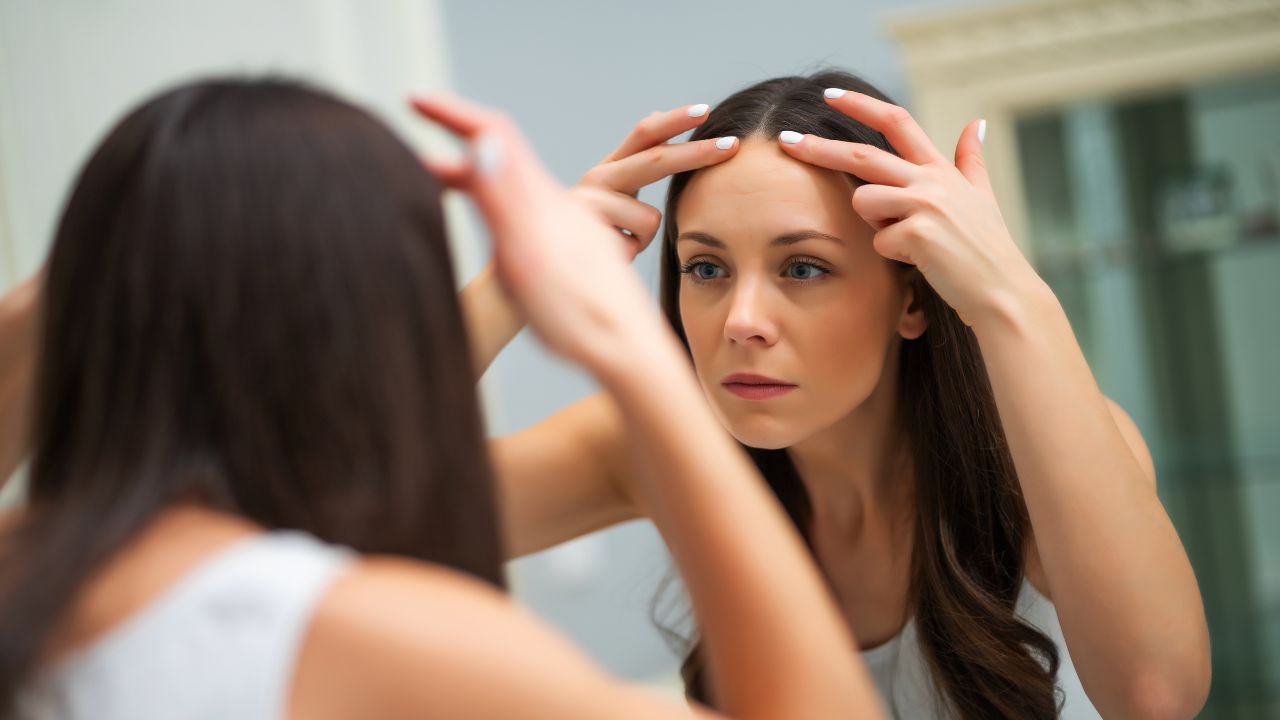Whether you’re dealing with a receding hairline or simply want to increase the fullness of your forehead hair, Natural Ways To Grow Forehead Hair can be an appealing choice. In a world with countless hair products and treatments available, the temptation of using nature’s ability to enhance hair is alluring. In this article, we take you through a step-by-step guide that will help you grow your forehead hair using only natural components. Say goodbye to pricier treatments and hello to a holistic strategy that blends the knowledge of traditional treatments with contemporary knowledge.
Prepare for a voyage that reveals the mysteries of how to unleash the potential for healthy, growing hair on your forehead using these natural wonders. So let’s explore nature’s gift and learn how to get a head full of beautiful, healthy hair. Head On to explore your in-house ingredients to grow forehead hair!
Forehead Hair
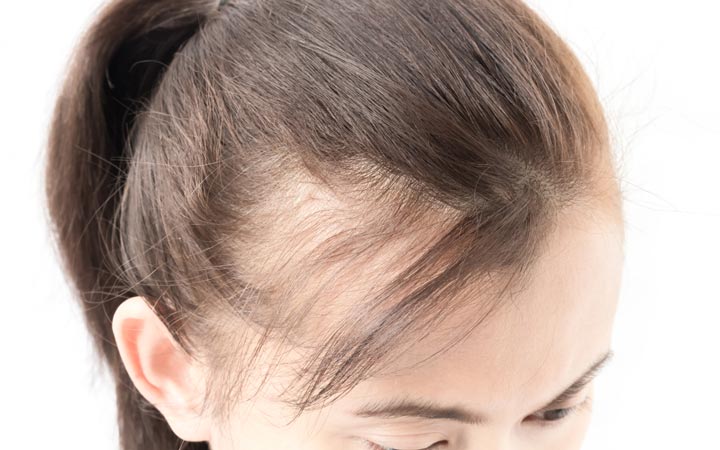
Forehead hair refers to the hair that grows on the forehead, particularly the area above the eyebrows and extending to the hairline. This differs from person to person and their forehead hair’s prominence and thickness. Some people may have a high or prominent hairline, in which case the position of their hairline makes their forehead wider or more prominent.
The look of forehead hair can also be affected by changes to the hairline, such as a widow’s peak or a receding hairline. When the hair surrounding the temples and frontal hairline gradually thins down or falls out, the hairline recedes, sliding backward. A V-shaped point in the hairline in the middle of the forehead is known as a widow’s peak. A number of variables, including heredity, age, hormonal changes, and specific medical problems, can influence the development and appearance of forehead hair. Conditions like male pattern baldness or female pattern hair loss, which are primarily brought on by hereditary and hormonal causes, can result in hair loss or thinning on the forehead.
Fun Fact: Did you know that forehead hair, also known as the “fringe,” has played a significant role in fashion and beauty trends throughout history?
Ways To Grow Forehead Hair
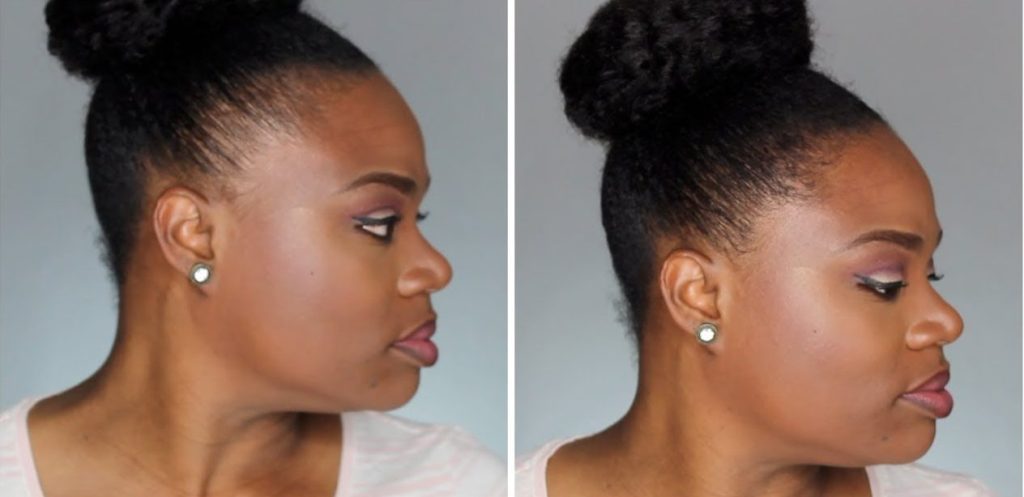
For those with a high or naturally receding hairline, growing forehead hair can be an issue. While it’s crucial to remember that genetics play a significant part in how much hair grows, there are a few techniques that could help encourage and boost hair growth in the forehead region. Keeping up a healthy lifestyle should come first. Essential nutrients for hair development can be obtained by eating a balanced diet that is high in vitamins, minerals, and proteins. The overall health of one’s hair is also influenced by regular exercise and stress management. Additionally, avoiding hairdos like tight braids or ponytails that pull on the hairline can lessen the risk of hair breakage and damage.
10 Natural Ways To Grow Forehead Hair
Many people wish they had thicker, fuller hair, especially on their foreheads. While several variables, such as genetics and general health, can influence hair development, including the hair on the forehead, natural ingredients and procedures in your hair care routine may assist in boosting hair growth there. These natural medicines have been utilized for millennia for their potential advantages. They are quite affordable and widely available.
Now we’ll look at ten all-natural techniques to get forehead hair, including using egg masks, coconut milk, fenugreek seeds, onion oil, aloe vera gel, coconut, castor, rosemary, olive, and apple cider vinegar. Knowing these natural components’ characteristics and how they might benefit the scalp and hair, you can take proactive steps towards healthier, fuller hair on your forehead. Continue reading and grab your favorite ingredient from below to grow forehead hair.
10 Natural Ways To Grow Forehead Hair
1. Onion Juice
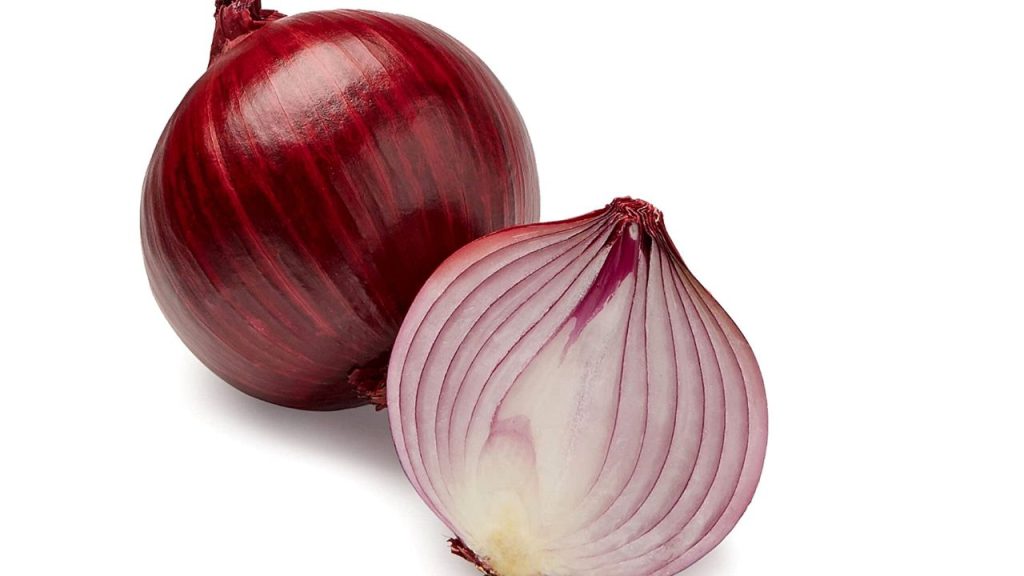
Onion oil is rich in sulfur, which helps improve blood circulation and nourish hair follicles. Antioxidants included in it may also help fight free radicals, lessen inflammation, and encourage hair growth. It is one of the best natural ways to grow forehead hair.
What to do:
- Peel and chop an onion into small pieces.
- Use a juicer to extract the juice or puree the onion pieces in a blender.
- Directly dab the onion juice along the hairline and forehead region.
- Keep it on for 30 to 60 minutes.
- To get rid of the onion juice odor, gently shampoo your forehead.
- For optimal results, repeat this procedure two or three times per week.
2. Aloe Vera Gel
Aloe vera gel offers soothing and moisturizing qualities that help keep the scalp healthy. It has enzymes that stimulate hair follicle growth, unclogs hair follicles, and remove dead skin cells from the scalp to encourage hair growth.

Steps to use:
- Cut a fresh aloe vera leaf and extract the gel.
- Directly massage the gel into your forehead and scalp.
- For proper absorption, give it a few minutes of gentle massaging.
- Keep it on for 30 to 60 minutes.
- Use warm water to rinse your forehead.
- Do this procedure two or three times weekly.
3. Coconut Oil

Coconut oil is renowned for being moisturizing and nourishing. It aids in preventing protein loss from hair, which can cause hair loss and breakage. Additionally, lauric acid, which has antibacterial characteristics and might support a healthy scalp, is a component of coconut oil. Coconut oil is among the most used natural ways to grow forehead hair.
Steps to use:
- Take a small amount of coconut oil in your palm.
- Lightly reheat the oil by rubbing your hands together.
- Apply the warm oil in circular motions to your forehead and scalp.
- Keep it on all day or for at least a couple of hours.
- To get rid of the oil, gently shampoo your forehead.
- Do this procedure two or three times weekly.
4. Castor Oil
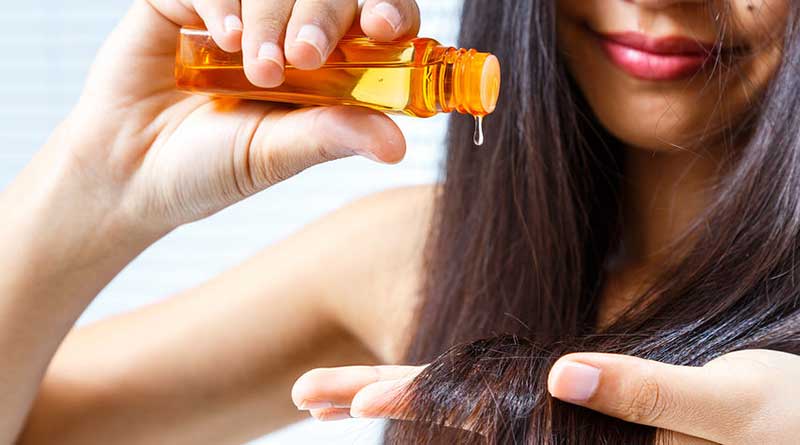
Castor oil is a nutrient- and fatty acid-rich, thick, viscous oil. For millennia, people have used it to encourage hair growth. Therefore, Castor oil strengthens the hair shaft, stimulates blood flow to the scalp, and aids in nourishing the hair follicles.
Steps to use:
- Take a few drops of castor oil in your palm.
- Focus on the hairline as you massage the oil into your scalp and forehead.
- Leave it on for a few hours or overnight.
- Use a gentle wash to rinse your forehead.
- Do this procedure two or three times weekly.
5. Rosemary Oil
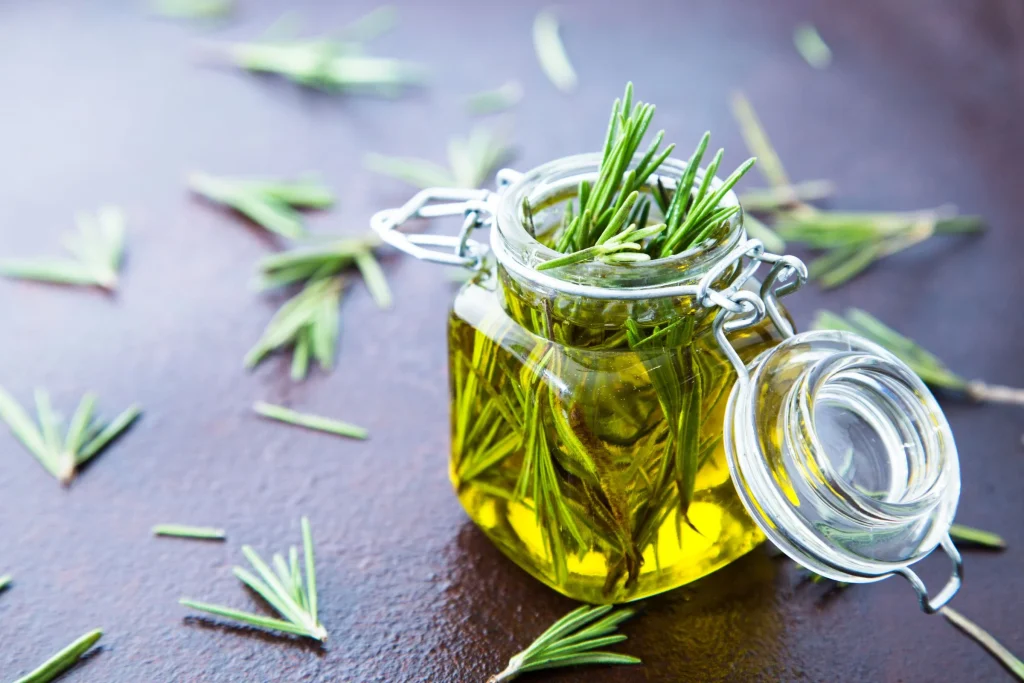
Rosemary oil has long been used to promote hair development. It might aid in boosting blood flow to the scalp, which might encourage the activity of hair follicles. Additionally, rosemary oil possesses antibacterial qualities that might support hair health.
Steps to use:
- Mix a few drops of rosemary oil with carrier oil, such as coconut oil or olive oil.
- Massage the oil mixture into your forehead and scalp.
- Gently massage it for a few minutes.
- Keep it on for 30 to 60 minutes.
- Use warm water to rinse your forehead.
- Do this procedure two or three times weekly.
6. Egg Mask
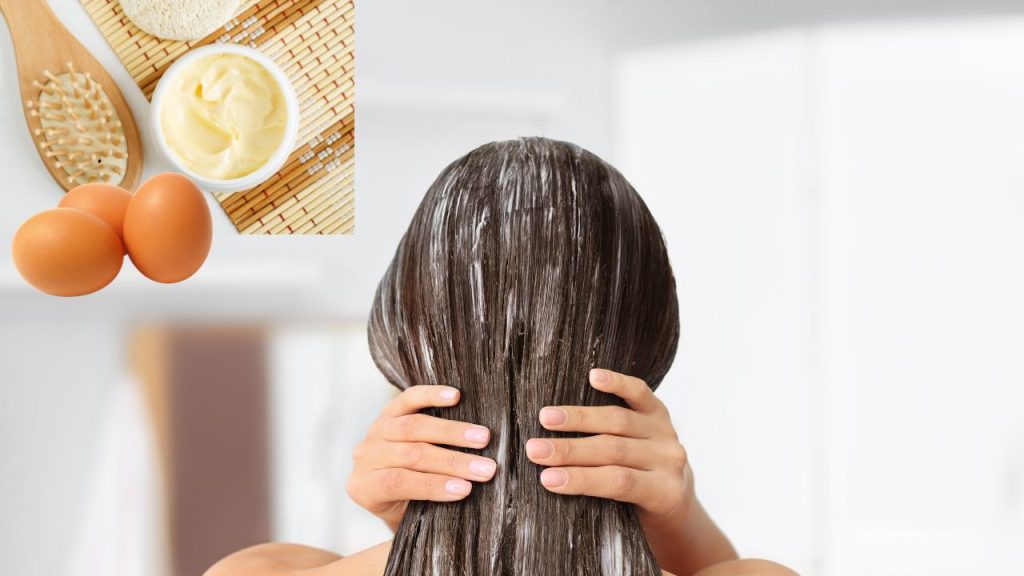
Eggs are rich in protein, vitamins, and minerals essential for healthy hair growth. The scalp can receive nourishment, the hair follicles can be strengthened, and hair growth can be accelerated by using an egg mask.
Steps to use:
- Take one or two eggs, depending on your hair length.
- Combine the eggs in a smooth consistency by beating them.
- Focus on the hairline as you apply the egg mixture to your scalp and forehead.
- Keep it on for 30 to 60 minutes.
- To stop the eggs from drying in your hair, thoroughly rinse your forehead with cool water.
- To get rid of any egg residue, gently shampoo your forehead.
- Do this procedure once every week.
7. Coconut Milk
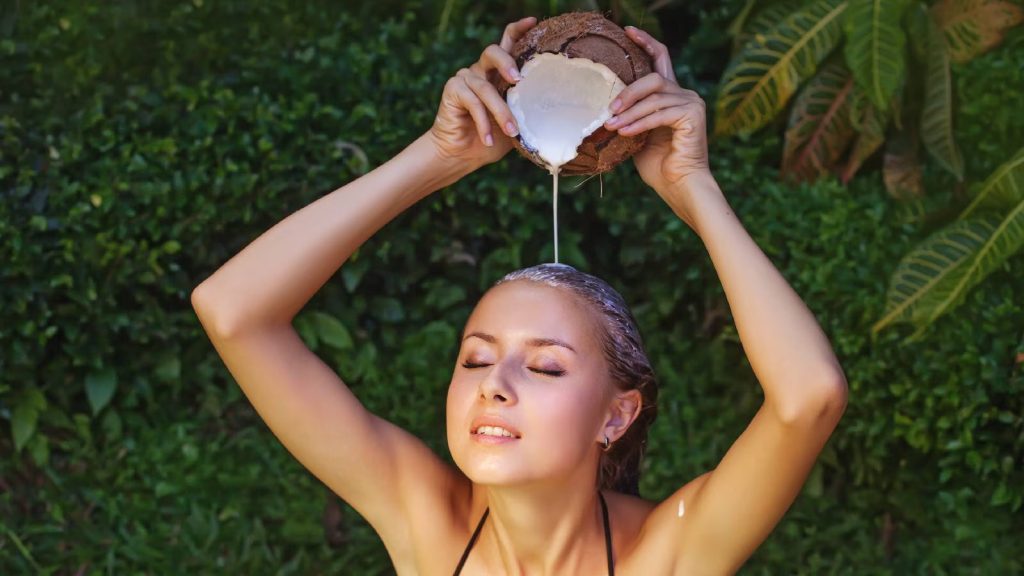
Proteins and lipids in coconut milk are vital nutrients that nourish hair follicles and encourage hair growth. Additionally, this natural way to grow forehead hair moisturizes the scalp, preventing dryness and fostering a favorable environment for hair growth.
Steps to use:
- Use store-bought coconut milk or extract fresh coconut milk from a mature coconut.
- Directly massage the coconut milk into your scalp and forehead, paying particular attention to the hairline.
- Spend a few minutes gently massaging the milk into your scalp.
- Leave it on for between 30 and 60 minutes.
- Use warm water to wash your forehead.
- Several times a week, repeat this method.
8. Fenugreek Seeds

Fenugreek seeds are rich in proteins, nicotinic acid, and lecithin, which can help strengthen hair follicles and promote hair growth. This natural way to grow forehead hair is available even in your kitchen. Additionally, fenugreek seeds contain hormone precursors that can aid in promoting hair growth.
Steps to use:
- Overnight, soak two teaspoons of fenugreek seeds in water.
- Grind the soaked seeds into a paste in the morning.
- Focus on the hairline when applying fenugreek paste to your scalp and forehead.
- For 30 to 60 minutes, leave it on.
- Rinse your forehead with warm water while giving your scalp a little massage.
- Several times, repeat this procedure.
9. Olive Oil

Olive oil is a rich source of antioxidants and healthy fats, which can help nourish the hair follicles and promote hair growth. This natural way to grow forehead hair also lessens irritation and moisturizes the scalp.
Steps to use:
- In your palm, take a small amount of olive oil.
- By rubbing your hands together, warm the oil.
- Massage your scalp and forehead with warm oil, paying close attention to the hairline.
- Leave it on overnight for best results, or at least for a couple of hours.
- To get the oil from your forehead, gently cleanse it with shampoo.
- Several times a week, repeat this method.
10. Apple Cider Vinegar
A healthy scalp environment requires a pH balance, which apple cider vinegar helps to maintain. Hence, it can unclog hair follicles and remove product buildup, encouraging healthy hair development. One of the most commonly used natural ways to grow forehead hair.
Steps to use:
- Combine apple cider vinegar and water in an equal amount.
- Pour the diluted liquid over your scalp and forehead after shampooing.
- For a few minutes, massage the mixture into your scalp.
- Keep it running for 5 to 10 minutes.
- For the vinegar odor to go away, wash your forehead with water.
- Once each week, repeat this method.
Fun Fact: A high forehead was considered a sign of beauty and intelligence in ancient Egypt. To enhance their forehead’s appearance, both men and women would shave their eyebrows and wear wigs adorned with decorative headbands.
How To Take Care Of Forehead Hair?
Taking care of forehead hair involves following a good hair care routine and adopting healthy habits. You must take a few essential steps to care for your forehead hair.
- Use a gentle shampoo to gently clean your hair, massaging the scalp to encourage blood flow. Apply a moisturizing conditioner to the hair, paying particular attention to the lengths and ends to feed and hydrate it.
- Use heat styling equipment sparingly, and shield the hair on your forehead from UV radiation with a hat or UV protection creams. Therefore, keep natural oils, avoid overwashing, and frequently trim your hair to prevent split ends.
- Your forehead hair will be healthier overall and easier to maintain if you consume a balanced diet, use soft hairstyle products, massage your scalp, and avoid using too many harsh chemical treatments.
Tips for maintaining hair on the forehead:
- Gentle Cleaning: Wash your hair and scalp with a gentle shampoo. Avoid using strong products that might dry out your skin by removing natural oils.
- Limit tools that generate heat, such as flat irons, curling irons, and blow dryers. The hair might become dry and brittle from overheating, which can harm the hair follicles.
- Sun exposure can harm hair, so shield the hair on your forehead from the sun’s damaging UV rays. When spending time outside, put on a cap or apply a hair product with UV protection.
- Regular Trimming: Regular hair cuts generally help keep your hair healthy by removing split ends. Trimming every six to eight weeks will stop the damage from moving up the hair shaft.
- Avoid Overwashing: Overwashing can remove natural oils from your hair and dry it. Aim to wash your hair every two to three days, depending on your hair type and lifestyle.
- Balanced Diet: Consume a healthy, vitamin- and mineral-rich diet to support the health of your hair. To nourish your hair from the inside out, include fruits, vegetables, lean proteins, and healthy fats.
- Massage your scalp regularly to promote blood flow and promote hair development. With your fingertips, massage the head in a circular motion, beginning at the forehead and working backward.
- Avoid using harsh chemicals as much as possible, such as relaxers, perms, and excessive hair coloring. These have the potential to weaken and harm hair follicles.
Fun Fact: Did you know that forehead hair, also known as the “widow’s peak,” has an intriguing connection to mythology? The term “widow’s peak” originates from the belief that a woman with a pointed or V-shaped hairline in the center of her forehead was destined to outlive her husband. This notion stemmed from an old European superstition that linked the widow’s peak to widowhood.
FAQs [Frequently Asked Questions And Answers]
Q: Are there any specific vitamins or supplements that can promote hair growth?
A: A balanced diet or dietary supplements can provide many vitamins and minerals that are linked to hair development. Biotin, vitamin C, vitamin D, vitamin E, zinc, and iron are a few examples. Before beginning any new supplements, speaking with a medical expert is crucial.
Q: Are there any lifestyle habits that can hinder hair growth?
A: Some lifestyle choices could prevent hair from growing. These include overindulging in tobacco and alcohol use, eating poorly, sleeping little, experiencing high levels of stress, and using harsh hair care methods. A healthy lifestyle, in general, helps support healthy hair development.
Q: How long does it take to see results from natural hair growth methods?
A: Hair development is a gradual process, and individual factors like genetics, general health, and persistence in using hair growth practices can all affect how it turns out. Before observable changes are observed, it can take a few weeks or even months.
Q: Can natural remedies alone regrow hair on the forehead?
A: Although they may not be effective for everyone in the process of regrowing hair on the forehead, natural therapies can assist in enhancing the quality of the hair and scalp. Individual outcomes may differ, and extreme hair loss may necessitate medical attention or further treatment alternatives.
Q: When should I consult a healthcare professional about hair loss on my forehead?
A: A dermatologist or healthcare provider should be seen if you have substantial hair loss on your forehead or if natural therapies don’t seem to be working. They can assess your particular circumstance, determine any underlying problems, and provide suitable treatment alternatives.
Final Words
Embracing and nurturing your forehead hair growth naturally is achievable and empowering. You can control the health of your hair and see the transformation you want by implementing these ten natural procedures into your hair care routine. Remember that patience is essential for hair growth and revival, so you should religiously be persistent with your routine and allow your hair the time it needs to grow. Hence each action you do to promote natural hair growth is a step towards accepting your beauty, whether it’s massaging your scalp, providing it with essential oils, or changing your lifestyle. Accept the trip, rejoice in your accomplishments, and treat yourself nicely as you go.
Let the hair on your forehead, as it grows, represent your strength, self-care, and dedication to your unique beauty. Remember that each strand of your hair tells a story about your personal development and represents who you are. Be consistent, patient, and, most of all, confident in your choice to let your forehead hair grow naturally.


